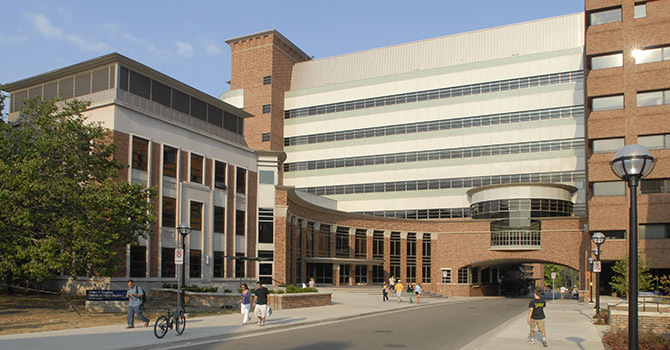School of Public Health Takes First Place in Statewide Energy Competition

When it comes to reducing energy consumption and carbon footprints, it's good to be a big loser. At the fourth annual Michigan Energy Summit, held in Grand Rapids in April, the University of Michigan swept the education category of the 2018 Michigan Battle of the Buildings competition, with the School of Public Health taking first place.
With the leadership of facilities manager Jim Kennedy, the School of Public Health reduced energy consumption by an impressive 34.57 percent in 2017 compared to 2016. "There were over 2,000 entries from across the state—hotels, banks, schools, all kinds of competition. The School of Public was not only number one in the education category but was the overall top loser—of energy consumption—in the entire state, even though that wasn't formally recognized," said Andrew Cieslinski, mechanical engineer lead with the Architecture, Engineering, and Construction division of University of Michigan Facilities and Operations.
The university announced in 2017 its commitment to reducing its carbon footprint by 25 percent by 2025 and each year selects buildings to submit to the Battle of the Buildings competition. The Michigan Energy Summit is open to all commercial, industrial, and multi-family buildings in Michigan. The contest was designed to encourage energy-efficient practices and to foster a spirit of friendly competition among building owners and operators where ideas and successes could be shared.
"Hoods not in use, when not properly sealed, still use a lot of energy."
—Jim Kennedy
Kennedy and Cieslinski spent much of 2016 and 2017 looking at laboratory fume hoods, ventilation devices that are installed in many lab spaces. "The hoods are made to remove hazardous room air and backfill with fresh air, to protect the researcher. Hoods in use consume a lot of energy, and they should. Hoods not in use, when not properly sealed, still use a lot of energy," said Kennedy.
Kennedy worked with the school's lab users group to identify unused hoods and to discuss opportunities for space efficiencies. "Debbie Struhar, our facilities support lead, reorganized some labs to accommodate multiple users on single, larger hoods so we could shut down hoods in other labs when there just wasn't enough use to justify keeping three or four smaller hoods open," said Kennedy.
According to Cieslinski, a single hood can consume over $5,000 a year of energy when used normally, making these common devices an attractive focus for reducing consumption across the university. "We were able to take Jim's processes for hibernating hoods to reduce energy costs at the School of Public Health and use those ideas around campus for energy savings in other buildings," Cieslinski said.
Keeping these traps updated saves thousands of dollars in energy costs annually.
Ventilation hoods are just a piece of the energy-savings puzzle. Kennedy and team installed occupancy sensors around the school in office and meeting spaces, classrooms, and anywhere else people might be gone for long periods of time. The sensors turn off individual room lighting and can even control HVAC settings for additional savings.
The team regularly tests and replaces failing steam traps, devices that send hot water back to the central power plant for recycling while keeping needed steam in the building. Keeping these traps updated saves thousands of dollars in energy costs annually. With lighting, now that LEDs make financial sense, they are moving from 32w fluorescent bulbs to 10w LEDs, a change that results in huge savings.
Kennedy and Cieslinski really enjoy the creative challenges and opportunities to think outside the box. The partnership helps Cieslinski's team implement efficiencies across campus. "A close relationship between energy management and an attentive, expert building manager like Jim is that we have his eyes and ears on the ground every day and can use his insights in other spaces. Meanwhile, he gets to hear what other places have tried and what is working for them. The lab hibernation initiative is a great example of how Jim pioneered an innovative idea that worked really well and has now been used across campus," Cieslinski said.
Kennedy applauds leadership at the School of Public Health for their desire to remain financially responsible and to reduce the school's carbon footprint. "Andrew and I don't operate in a vacuum. The support and encouragement I get from the dean's office to pursue these projects is a real difference maker. It's a team effort all around," he said.
